By Noel Michaels
Fall Stars Weekend is upon us, which means it’s time for the prestigious Keeneland fall meet, opening Friday (Oct. 8) for 17 days of racing over three weeks in Lexington, Kentucky, the center of thoroughbred horse racing.

The start of the Blue Grass Stakes at Keeneland – Photo Courtesy of Michael Clevenger/Courier Journal
The first three days of the meet are loaded with stakes races featuring some of the leading contenders for next month’s Breeders’ Cup, and others still vying for fees-paid “Win and You’re In” berths. The meet runs through Oct. 30 and is sure to attract large fields for every race card.
Keeneland’s 18 stakes races include six Grade 1’s – five this weekend. On Saturday, the card offers five graded stakes with three Grade 1’s.
When looking ahead to the Breeders’ Cup, it’s important to remember that the winners of more than 40 BC races have made their final prep at Keeneland’s fall meet. Keeneland’s most productive preps in that regard have been in the Thoroughbred Cub of America (F&M Sprint), Spinster (Distaff), Shadwell Turf Mile (Mile), Alcibiades (Juvenile Fillies), and Breeders’ Futurity (Juvenile).
Since Keeneland’s fall season is short and the meet’s stakes are front-loaded so they can be Breeders’ Cup prep races, the time is now for handicappers to brush up on some things you’ll need to know to make a little money.
Inside information
Keeneland was always known as an inside speed paved highway in terms of handicapping. That all changed during Keeneland’s Polytrack era, but that good old rail has returned on the main track and handicappers need to factor that in.
Post 1 can be expected to win about 15 percent in dirt sprints and at around 20 percent in dirt routes. For example, at the 2021 Keeneland spring meet, the rail won 14% of the dirt sprints and 19% in dirt routes, where the inside two post positions won a total of 19 of the 70 races run for a huge 41% from those two posts alone.
In dirt sprints, horses seem to have their chance all the way out to post 7, until the win percentages start to drop off. In two-turn dirt route races at a mile or more, horses can also win from any part of the starting gate, but overall, the inside posts 1-2 are great, while horses in those races drawn anywhere outside post 8 struggle mightily.
Think running styles
As far as the preferred Keeneland main track running styles, horses have their best chances to win by staying within two lengths of the lead at the first call in sprints, and within four lengths of the lead at the first call in routes. Front runners do best at 6 furlongs (20% wire-to-wire and 33% of the winners on or close to the pace), and at 1 1/16 miles (with about 20% wire-to-wire winners).
The other main staple of the quality day-to-day racing at Keeneland is the great turf racing, which features big full fields, tons of value, and loads of good overlays.
In terms of running style preferences on the Keeneland turf, it’s better to stay on or close to the pace than it is to try to come from too far back, and most winners have already led or gotten within 2 ½ lengths at the half-mile marker. Closers have their best chance on the grass in longer races at 1 1/8 miles and beyond.
Post positions are a factor
Post positions are an important handicapping factor on the Keeneland grass course, and this will play out throughout the meet. In Keeneland turf routes, inside posts are good, but middle posts are also fine out to post 7. The far outside posts, however, are not great at most distances on the Keeneland grass. Based on a large sample size in turf routes run at Keeneland since the fall of 2014, various posts 1-7 yield about 12% percent win percentages, but the outside posts average far worse. The least advantageous distance for outside posts is at 1-mile, and the absolute worst posts for all turf routes at Keeneland are posts 10 and out. Those posts combined to go 0-for-47 a few years ago and have been only slightly better ever since.
Turf sprint stats
Keeneland doesn’t card very many turf sprints. There were only 15 at the 2021 spring meet and a similar amount is in the condition book at this meet. With stats in these races going back to 2006 you can build a Keeneland turf sprint winning profile despite the fact they don’t run many annually. Based on the long-range stats, Keeneland’s off-the-pace runners that rally from between two lengths and six lengths behind with a half-mile to run, and horses from middle-to-outside posts tend to do all right. However, this was not the case at the most recent Keeneland meet in spring 2021 when 12 of the 15 winners broke from posts 1-5, and 12 of the 15 winners already led or had gotten within 2 ½ lengths of the front coming into the home stretch.
The first part of the Keeneland fall meet is all about Breeders’ Cup “Win and You’re In” prep races, but after the opening week fireworks subside, there is only one Grade 1 left – the Queen Elizabeth II on Oct. 16.
Jockey trends
The jockey standings look different in the fall than in the spring. This past spring, Luis Saez beat out Joel Rosario for the riding title 29 wins to 22. At the fall meet, however, except for stakes day appearances, Saez and Rosario and jockeys like Irad Ortiz, Jr. and Jose Ortiz ride full time at Belmont.
The Keeneland fall meet jockey’s room is more about the usual Kentucky faces, including 2020 Keeneland fall meet leading rider Tyler Gaffalione, as well as Florent Geroux, Brian Hernandez, James Graham, and 2019 Keeneland fall leader Julien Leparoux, and 2017 Keeneland fall champion Ricardo Santana, Jr.
Trainer trends
The top trainer at the 2020 Keeneland fall meet was Brad Cox, who posted a 15-for-39 mark last year for an impressive 38% win rate. He will be tough to dethrone. The hot trainer over the summer was Mike Maker, who had an exceptional Saratoga meet and then was leading trainer at the brief Kentucky Downs meet. He was second behind Cox last fall with a record of 12-for-48, 25%. Cox and Maker are likely to be followed in the trainer standings by Steve Asmussen, Wesley Ward, and Chad Brown. Other trainers who can usually be counted on to invade Keeneland with live runners include the New York contingent of Bill Mott, Shug McGaughey, and Christophe Clement. The local circuit of trainers also will compete at every level, and they include Ken McPeek, Dale Romans, Eddie Kenneally, and Robertino Diodoro.

Noel Michaels has been involved in many aspects of thoroughbred racing for more than two decades, as a Breeders’ Cup-winning owner and as a writer, author, handicapper, editor, manager and promoter of the sport for a wide range of companies including Daily Racing Form and Nassau County Off-Track Betting.
He also is regarded as the leading source of news and information for handicapping tournaments and the author of the “Handicapping Contest Handbook: A Horseplayer’s Guide to Handicapping Tournaments”, which made his name virtually synonymous with the increasingly-popular tournament scene.
In addition to contributing to US Racing, he is also an analyst on the Arlington Park broadcast team.


